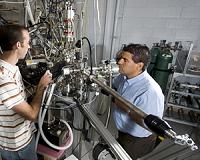 |
Princeton NJ (SPX) Nov 09, 2010 Researchers at the Princeton Plasma Physics Laboratory have successfully used Coaxial Helicity Injection (CHI) to generate plasma current and couple it to a conventional current generation method at the National Spherical Torus Experiment (NSTX) fusion experiment. After coupling, the combined process generated 1 million amperes of current using 40 percent less energy than needed to generate this current using the conventional means by itself, thus demonstrating that a high-quality initial magnetic configuration was produced by CHI. Plasma confinement devices based on the tokamak concept rely on a solenoid through the center of the device to generate the initial current. Because the solenoid is used as an electrical transformer, its pulse length is limited in duration and it cannot sustain the initial current indefinitely in a steady-state reactor. Thus a method to eliminate the solenoid would remove a large component from the center of the tokamak, making the device simpler and less expensive. This allows the freed space in the center to be used in optimizing the device, making the tokamak more efficient by producing a magnetic configuration similar to that in a spherical tokamak. CHI generates plasma currents by producing a magnetic bubble using magnetic reconnection. This is analogous to producing a soap bubble by blowing air through a ring dipped in soap solution. During CHI, currents are driven along magnetic filaments so that the resulting magnetic forces overcome the magnetic filament tension and cause the magnetic surface to stretch into the tokamak vessel. The figure below is a sequence of visible camera images that shows the bubble being generated on the lower part of NSTX and expanding to fill the entire vessel volume. Solar flares on the surface of the sun erupt and also reconnect through the process of magnetic reconnection. After this bubble has been created in NSTX it carries a current of more than 250 thousand amperes, which is 100 times more than the seed current used to initiate the discharge. As a result of this very high current multiplication factor the process is efficient and consumes less than one Joule of stored energy to generate 10 amperes of current. The CHI method has been studied in the smaller Helicity Injected Tokamak (HIT-II) at the University of Washington in which the current multiplication factor was six. NSTX is thirty times larger in volume, and researchers have found the process to be much more efficient on NSTX, indicating that the method scales well to future larger machines. In a steady-state reactor this initial current would be sustained by injecting high-energy particles. These particles would produce more current if the plasma density is small. For easier control of high-performance plasma, it is necessary that the distribution of the plasma current is preferentially driven near the outer edges of the magnetic configuration. The recent CHI discharges on NSTX have also generated the start-up current with these desired features needed for steady-state operation. These exciting new results, combined with the capability of CHI to produce a large amount of current at high efficiency in larger machines, bodes well for the application of this new method in future tokamaks and spherical tokamaks. These results will be presented in an invited talk at the American Physical Society, Division of Plasma Physics 52nd annual meeting on November 8-12 in Chicago.
Share This Article With Planet Earth
Related Links American Physical Society Powering The World in the 21st Century at Energy-Daily.com
 Findings Show Promise For Nuclear Fusion Test Reactors
Findings Show Promise For Nuclear Fusion Test ReactorsWest Lafayette IN (SPX) Aug 02, 2010 Researchers have discovered mechanisms critical to interactions between hot plasma and surfaces facing the plasma inside a thermonuclear fusion reactor, part of work aimed at developing coatings capable of withstanding the grueling conditions inside the reactors. Fusion powers the stars and could lead to a limitless supply of clean energy. A fusion power plant would produce 10 times more e ... read more |
|
| The content herein, unless otherwise known to be public domain, are Copyright 1995-2010 - SpaceDaily. AFP and UPI Wire Stories are copyright Agence France-Presse and United Press International. ESA Portal Reports are copyright European Space Agency. All NASA sourced material is public domain. Additional copyrights may apply in whole or part to other bona fide parties. Advertising does not imply endorsement,agreement or approval of any opinions, statements or information provided by SpaceDaily on any Web page published or hosted by SpaceDaily. Privacy Statement |